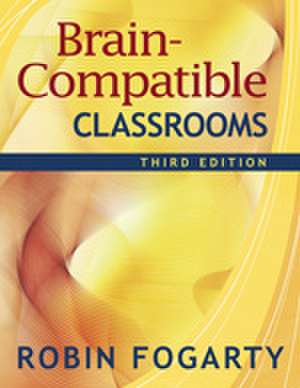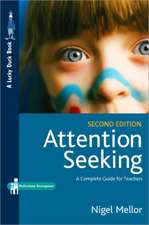Brain-Compatible Classrooms
Editat de Robin J. Fogartyen Limba Engleză Paperback – 9 iun 2009
| Toate formatele și edițiile | Preț | Express |
|---|---|---|
| Paperback (1) | 325.97 lei 6-8 săpt. | |
| SAGE Publications – 9 iun 2009 | 325.97 lei 6-8 săpt. | |
| Hardback (1) | 577.82 lei 6-8 săpt. | |
| SAGE Publications – 25 mai 2009 | 577.82 lei 6-8 săpt. |
Preț: 325.97 lei
Nou
Puncte Express: 489
Preț estimativ în valută:
62.37€ • 65.13$ • 51.51£
62.37€ • 65.13$ • 51.51£
Carte tipărită la comandă
Livrare economică 15-29 aprilie
Preluare comenzi: 021 569.72.76
Specificații
ISBN-13: 9781412938877
ISBN-10: 1412938872
Pagini: 248
Ilustrații: figures
Dimensiuni: 216 x 279 x 15 mm
Greutate: 0.68 kg
Ediția:Third Edition
Editura: SAGE Publications
Colecția Corwin
Locul publicării:Thousand Oaks, United States
ISBN-10: 1412938872
Pagini: 248
Ilustrații: figures
Dimensiuni: 216 x 279 x 15 mm
Greutate: 0.68 kg
Ediția:Third Edition
Editura: SAGE Publications
Colecția Corwin
Locul publicării:Thousand Oaks, United States
Recenzii
"A fine, useful update of Fogarty's long-time search for appropriate practical classroom applications of cognitive neuroscience research."
"An excellent guide and tool for new and veteran teachers who are looking to empower students through brain-compatible lessons."
"Relevant and applicable for teachers."
"An excellent guide and tool for new and veteran teachers who are looking to empower students through brain-compatible lessons."
"Relevant and applicable for teachers."
Cuprins
Preface
Acknowledgments
About the Author
Introduction
Part I. Physiology and Brain Science
1. Brain Science
The Brain Is the Universe Within
How to Be a Critical Consumer of Research on the Brain and Learning
Just the Facts! What Are the Facts About the Brain?
Macroview: A Look at the Exterior of the Human Brain
Geography of the Human Brain (Topography)
Three Views of the Brain
Top-to-Bottom View
Front-to-Back View
Left-to-Right View
How Has the Brain Evolved?
Microview: A Look at the Interior of the Human Brain
Brain Imaging: How We Know What We Know
How the Brain Works
Neurotransmitters
Differences Between Males and Females
Part II. Principles for Teaching and Learning
2. Principles of the Brain and Learning
The Bridge Between Brain Science and Cognitive Science
The Brain Principles and the Four-Corner Framework
Twelve Brain Principles of Caine and Caine
1. Learning Is Enhanced by Challenge and Inhibited by Threat
2. Emotions Are Critical to Patterning
3. Learning Involves Both Focused Attention and Peripheral Perception
4. The Brain Has a Spatial Memory System and a Set of Systems for Rote Learning
5. The Brain Processes Parts and Wholes Simultaneously
6. Learning Engages the Entire Physiology
7. The Brain Is a Parallel Processor
8. Learning Is Embedded in Natural and Social Settings
9. Each Brain Is Unique
10. The Search for Meaning Is Innate
11. The Search for Meaning Occurs Through Patterning
12. Learning Always Involves Conscious and Unconscious Processes
It's All About Learning
3. Cognitive Science: The Brain Is on My Mind
Brain Science and Cognitive Science
Nature Versus Nurture (Heredity Versus Environment)
Enriched Environments
Intelligence as a Function of Experience
Windows of Opportunity
Nutrition-Cognition Connection
Care and Feeding of the Brain
Abuses and Addictions
New Conclusions
Emotions and the Intellect
Safe Climate
Threat
Challenge
The Brain and the Mind
Brain Versus Mind
Theories of the Intellect
General Intelligence Theory: Spearman
Theory of Cognitive Modifiability: Feuerstein
Theory of Multiple Intelligences: Gardner
Successful Intelligence: Sternberg
Learnable Intelligence: Perkins
Intelligent Behaviors or Habits of Mind: Costa and Kallick
Emotional Intelligence: Goleman
Moral Intelligence: Coles
Memory, Learning, and the Human Brain
Memory Metaphor
It's on My Screen
It's on My Desktop
It's on My Menu
It's on My Hard Drive
Types of Memory Systems
Short-Term Memory
Long-Term Memory
Episodic, Procedural, Conditional, and Emotional Memory
Memory Lane: Semantic, Episodic, Emotional, Procedural, and Automatic
Declarative (Explicity) and Procedural (Implicit) Memory
Learning Through Patterns and Chunking
It's All About Teaching
Part III. Brain-Friendly Strategies
4. Strategies for Brain-Compatible Classrooms
The Four-Corner Framework
Brain-Compatible Classroom
Teaching FOR Thinking: Setting the Climate
Research Base - Physiology, Emotions, Environment
Principles of Brain-Compatible Learning
Implications for Learning
Implications for Teaching: Satisfactory
Teaching OF Thinking: Instructing Skills and Standards of Learning
Research Base - Brain, Mind, Intellect
Principles of Brain-Compatible Learning
Implications for Learning
Implications for Teaching: Good
Teaching WITH Thinking: Structuring Interactions
Research Base - Active Learning/Constructivist
Principles of Brain-Compatible Learning
Implications for Learning
Implications for Teaching: Excellent
Teaching ABOUT Thinking: Reflecting Metacognitively
Research Base - Deep Understanding/Transfer
Principles of Brain-Compatible Learning
Implications for Learning
Implications for Teaching: Superior
Definition and Description of Brain-Compatible Classrooms
Research on Teacher Quality
What Teachers Say
What Experts Say
What Kids Say
A Framework for Quality Revisited
5. Setting the Climate for Thinking
Brainwave #1: Emotions - Goleman/LeDeux/Coles
Braindrops: Strategies
Threat Alerts the Body
Challenge Engages the Intellect
Brainworks: Activities
People Search
Fat/Skinny Questions
The Human Graph
Brainwave #2: Enriched Environment - Diamond/Conyers and Wilson
Brainstorms: Application
Braindrops: Strategies
Organizational Enrichments
Sensory Enrichments
Brainworks: Activities
Four Corners
Brainstorms: Application
6. Teaching the Skills of Thinking
Brainwave #3: Microskills and Macroskills - Marzano/McTighe
Braindrops: Strategies
Microskills
Macroskills
Brainworks: Activities
Microskill Lesson - Analysis for Bias
Macroskill Lesson - Problem Solving
Brainstorms: Applications
Brainwave #4: Development of Skills and Concepts - Posner and Keele/Csikszentmihalyi
Braindrops: Strategies
Basic/Apprentice
Advanced/Master
Brainworks: Activities
Basic/Apprentice
Advanced/Master
Brainstorms: Applications
7. Structuring the Interaction With Thinking
Brainwave #5: Active Learning - Vygotsky/Ausbel
Braindrops: Strategies
Teacher Decisions for Cooperative Groups
BUILD Components/Cooperative Strategies
Graphic Organizers
Brainworks: Activities
Dealing With Paradox
Brainstorms: Application
Brainwave #6: Experiential Learning
Braindops: Strategies
Multiple Intelligences
Integrated Curriculum
Brainworks: Activities
Curriculum Corners
Brainstorms: Applications
8. Thinking About Thinking
Brainwave #7: Reflection
Braindrops: Strategies
Making Meaning
Transfer of Learning
Brainworks: Activities
Transfer Tales
Brainstorms: Applications
Brainwave #8: Assessment
Braindrops: Strategies
Traditional Assessments
Dynamic Assessments
Brainworks: Activities
Folk Portfolio
Brainstorms: Application
Appendix A: Suggested Videos to Illustrate the Four-Corner Framework
Appendix B: The Brain
Glossary
References and Suggested Readings
Index
Acknowledgments
About the Author
Introduction
Part I. Physiology and Brain Science
1. Brain Science
The Brain Is the Universe Within
How to Be a Critical Consumer of Research on the Brain and Learning
Just the Facts! What Are the Facts About the Brain?
Macroview: A Look at the Exterior of the Human Brain
Geography of the Human Brain (Topography)
Three Views of the Brain
Top-to-Bottom View
Front-to-Back View
Left-to-Right View
How Has the Brain Evolved?
Microview: A Look at the Interior of the Human Brain
Brain Imaging: How We Know What We Know
How the Brain Works
Neurotransmitters
Differences Between Males and Females
Part II. Principles for Teaching and Learning
2. Principles of the Brain and Learning
The Bridge Between Brain Science and Cognitive Science
The Brain Principles and the Four-Corner Framework
Twelve Brain Principles of Caine and Caine
1. Learning Is Enhanced by Challenge and Inhibited by Threat
2. Emotions Are Critical to Patterning
3. Learning Involves Both Focused Attention and Peripheral Perception
4. The Brain Has a Spatial Memory System and a Set of Systems for Rote Learning
5. The Brain Processes Parts and Wholes Simultaneously
6. Learning Engages the Entire Physiology
7. The Brain Is a Parallel Processor
8. Learning Is Embedded in Natural and Social Settings
9. Each Brain Is Unique
10. The Search for Meaning Is Innate
11. The Search for Meaning Occurs Through Patterning
12. Learning Always Involves Conscious and Unconscious Processes
It's All About Learning
3. Cognitive Science: The Brain Is on My Mind
Brain Science and Cognitive Science
Nature Versus Nurture (Heredity Versus Environment)
Enriched Environments
Intelligence as a Function of Experience
Windows of Opportunity
Nutrition-Cognition Connection
Care and Feeding of the Brain
Abuses and Addictions
New Conclusions
Emotions and the Intellect
Safe Climate
Threat
Challenge
The Brain and the Mind
Brain Versus Mind
Theories of the Intellect
General Intelligence Theory: Spearman
Theory of Cognitive Modifiability: Feuerstein
Theory of Multiple Intelligences: Gardner
Successful Intelligence: Sternberg
Learnable Intelligence: Perkins
Intelligent Behaviors or Habits of Mind: Costa and Kallick
Emotional Intelligence: Goleman
Moral Intelligence: Coles
Memory, Learning, and the Human Brain
Memory Metaphor
It's on My Screen
It's on My Desktop
It's on My Menu
It's on My Hard Drive
Types of Memory Systems
Short-Term Memory
Long-Term Memory
Episodic, Procedural, Conditional, and Emotional Memory
Memory Lane: Semantic, Episodic, Emotional, Procedural, and Automatic
Declarative (Explicity) and Procedural (Implicit) Memory
Learning Through Patterns and Chunking
It's All About Teaching
Part III. Brain-Friendly Strategies
4. Strategies for Brain-Compatible Classrooms
The Four-Corner Framework
Brain-Compatible Classroom
Teaching FOR Thinking: Setting the Climate
Research Base - Physiology, Emotions, Environment
Principles of Brain-Compatible Learning
Implications for Learning
Implications for Teaching: Satisfactory
Teaching OF Thinking: Instructing Skills and Standards of Learning
Research Base - Brain, Mind, Intellect
Principles of Brain-Compatible Learning
Implications for Learning
Implications for Teaching: Good
Teaching WITH Thinking: Structuring Interactions
Research Base - Active Learning/Constructivist
Principles of Brain-Compatible Learning
Implications for Learning
Implications for Teaching: Excellent
Teaching ABOUT Thinking: Reflecting Metacognitively
Research Base - Deep Understanding/Transfer
Principles of Brain-Compatible Learning
Implications for Learning
Implications for Teaching: Superior
Definition and Description of Brain-Compatible Classrooms
Research on Teacher Quality
What Teachers Say
What Experts Say
What Kids Say
A Framework for Quality Revisited
5. Setting the Climate for Thinking
Brainwave #1: Emotions - Goleman/LeDeux/Coles
Braindrops: Strategies
Threat Alerts the Body
Challenge Engages the Intellect
Brainworks: Activities
People Search
Fat/Skinny Questions
The Human Graph
Brainwave #2: Enriched Environment - Diamond/Conyers and Wilson
Brainstorms: Application
Braindrops: Strategies
Organizational Enrichments
Sensory Enrichments
Brainworks: Activities
Four Corners
Brainstorms: Application
6. Teaching the Skills of Thinking
Brainwave #3: Microskills and Macroskills - Marzano/McTighe
Braindrops: Strategies
Microskills
Macroskills
Brainworks: Activities
Microskill Lesson - Analysis for Bias
Macroskill Lesson - Problem Solving
Brainstorms: Applications
Brainwave #4: Development of Skills and Concepts - Posner and Keele/Csikszentmihalyi
Braindrops: Strategies
Basic/Apprentice
Advanced/Master
Brainworks: Activities
Basic/Apprentice
Advanced/Master
Brainstorms: Applications
7. Structuring the Interaction With Thinking
Brainwave #5: Active Learning - Vygotsky/Ausbel
Braindrops: Strategies
Teacher Decisions for Cooperative Groups
BUILD Components/Cooperative Strategies
Graphic Organizers
Brainworks: Activities
Dealing With Paradox
Brainstorms: Application
Brainwave #6: Experiential Learning
Braindops: Strategies
Multiple Intelligences
Integrated Curriculum
Brainworks: Activities
Curriculum Corners
Brainstorms: Applications
8. Thinking About Thinking
Brainwave #7: Reflection
Braindrops: Strategies
Making Meaning
Transfer of Learning
Brainworks: Activities
Transfer Tales
Brainstorms: Applications
Brainwave #8: Assessment
Braindrops: Strategies
Traditional Assessments
Dynamic Assessments
Brainworks: Activities
Folk Portfolio
Brainstorms: Application
Appendix A: Suggested Videos to Illustrate the Four-Corner Framework
Appendix B: The Brain
Glossary
References and Suggested Readings
Index
Descriere
Brain-Compatible Classrooms shares key brain research and its implications for curriculum, instruction, and assessment in the primary-college classroom.














